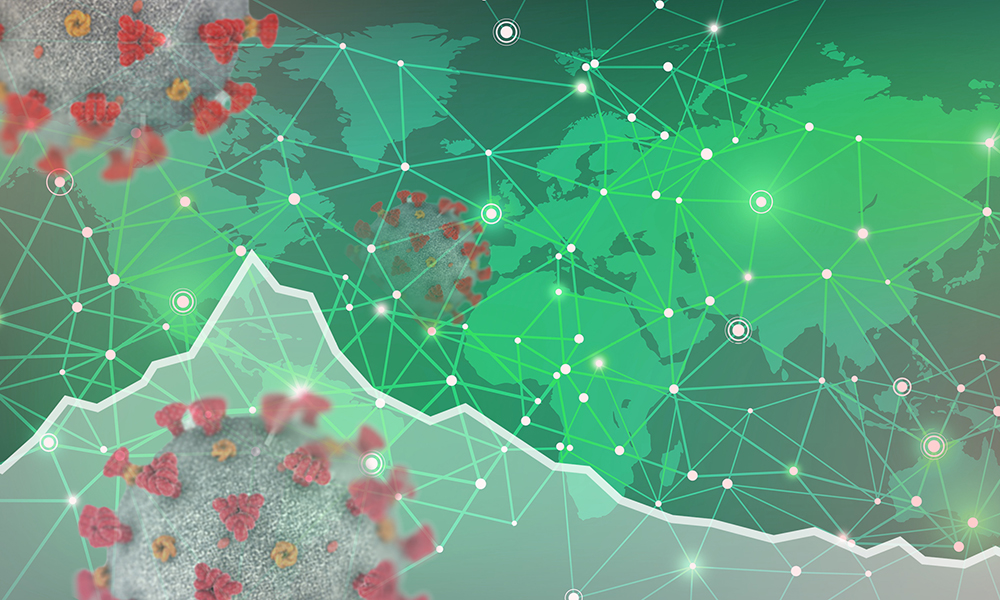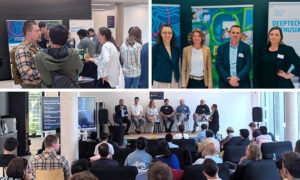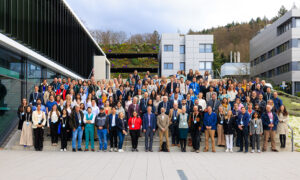
Just the gist: Big data and pandemics in seven key points
EMBL Science and Society panel examines opportunities and limitations for big data in addressing present and future pandemics

The use of data has played a central role in the COVID-19 pandemic, but it should come as no surprise that researchers are already looking at ways to improve data acquisition, management, and access. EMBL’s most recent Science and Society seminar, ‘Harnessing Big Data to Monitor and Tackle Pandemics’, featured a panel of three speakers who shared their experiences and conclusions about these topics.
Ilaria Capua, Director of the One Health Center of Excellence at the University of Florida, explained why the concept of ‘circular health’ could transform what we know about pandemics and how we address them. Enrico Bucci, Director of the System Biology programmes at Temple University in Philadelphia, discussed the limitations of big data and the idea of long-term pandemic forecasting. And Rolf Apweiler, Director of EMBL’s European Bioinformatics Institute (EMBL-EBI) and Senior Scientist, focused on the ways in which big data is most suited to answering specific questions about the pandemic. Ewan Birney, EMBL Deputy Director General and Director of EMBL-EBI, moderated the discussion and took questions from the audience.
Here are seven key messages to take away.
1. The COVID-19 pandemic is the most measured event in human history.
As the panellists acknowledge, this pandemic has generated and continues to generate a deluge of data on virus genomics, patient symptoms, COVID-19 test results, treatment approaches, safety and effectiveness of vaccines, and data related to geography, the environment, and animal vectors. Rather than presenting one clear picture, these are more like puzzle pieces on the floor, as Rolf describes them. The result has been disparate interpretations from different fields of science. The good news is that scientists have a lot of information – even about new viral variants.
2. Having a lot of data is not a panacea.
Even though researchers have tremendous amounts of information, there’s a limit to what it can do. Described by Enrico as “deterministic chaos”, the COVID-19 pandemic is a situation where we may know all the previous circumstances we’ve been in, but we still can’t say what will happen next because the system is chaotic. In these situations, there’s a limit to how accurately we can predict when the next wave will start or how long it will last. We also need to continue improving our ability to mine the data and to do so quickly.
3. Be critical of your data.
Researchers who work with only part of the data may only see part of the story. It’s incumbent on researchers to be sceptical of their data, tracking back to evaluate its coherence and integrity.
4. Collaboration is crucial.
Scientific collaboration provides many benefits: most importantly, a broader perspective that can bring together scientific disciplines and provide a more meaningful understanding of risks of infection.
5. There’s value in near-casting.
While there may be limitations to long-term forecasting, there’s potential for near-casting (e.g. a 10-day forecast of the pandemic in your neighbourhood). After ten days, models can diverge a lot. And ‘now-casting’ is equally important, if not more important, says Ewan. Unfortunately, our understanding of ‘now’ is rather imprecise.
6. One of the challenges is that human beings don’t see themselves as animals.
People live in the context of their environments, not in isolation. Ilaria outlined the idea of ‘circular health’, which aims to “co-advance what we know about humans, plants, and animals in one system”. Collaborative, international research is central to gaining a better understanding of diseases that move between animals and humans, and the way this transmission is connected to the changing environments we share.
7. Policymakers and politicians need to know science.
The question-and-answer session highlighted the need for policymakers to understand science if they’re to develop effective policies and communicate meaningful messages to the public. That can mean electing scientists and science-literate candidates.
Want more than just the highlights? Watch the whole panel discussion online.
Big data e pandemie in sette punti chiave
Il convegno EMBL di Scienza e Società esamina le opportunità e i limiti dei big data nell’affrontare le pandemie presenti e future.

L’uso dei dati è stato centrale nella pandemia COVID-19, ma non sorprende certo che i ricercatori stiano già esplorando come migliorare l’acquisizione, la gestione e l’accesso a questi dati.
L’EMBL ne ha parlato in un recente evento dedicato a Scienza e Società, “Harnessing Big Data to Monitor and Tackle Pandemics” (“Raccogliere dati per monitorare e affrontare la pandemia”), che ha visto la partecipazione di tre relatori che hanno condiviso le loro esperienze e riflessioni su queste questioni.
Ilaria Capua, Direttrice del One Health Center of Excellence presso l’Università della Florida, ha spiegato perché il concetto di ‘salute circolare’ sia in grado di trasformare potenzialmente ciò che sappiamo sulle pandemie e il modo in cui le affrontiamo. Enrico Bucci, Direttore dei programmi di biologia dei sistemi alla Temple University di Philadelphia, ha discusso i limiti dei big data e l’idea di utilizzarli per prevedere l’andamento delle pandemie a lungo termine. Rolf Apweiler, Direttore dell’Istituto Europeo di Bioinformatica dell’EMBL (EMBL-EBI) e Senior Scientist, ha illustrato come i big data siano i più adatti a rispondere a domande specifiche sulla pandemia. Infine, Ewan Birney, vice Direttore Generale dell’EMBL e direttore dell’EMBL-EBI, ha moderato la discussione e ha risposto alle domande del pubblico.
Ecco sette messaggi chiave da portare a casa.
1. La pandemia COVID-19 è l’evento più misurato nella storia umana.
Come riconosciuto dai relatori, questa pandemia ha generato e continua a generare un’incredibile mole di dati sulla genomica del virus, sui sintomi dei pazienti, sui risultati dei test COVID-19, sugli approcci terapeutici, sulla sicurezza e l’efficacia dei vaccini e sui dati relativi alla geografia, all’ambiente e ai vettori animali. Piuttosto che presentare un quadro chiaro, queste informazioni sono sparpagliate come un mucchio di pezzi di un puzzle sul pavimento, dice Apweiler. Questo ha portato alle interpretazioni più disparate da parte di ricercatori provenienti da diversi campi della scienza. Ma la buona notizia è che gli scienziati hanno a disposizione molte informazioni – anche sulle nuove varianti virali.
2. Avere molti dati non è una panacea.
Anche se i ricercatori hanno una quantità enorme di informazioni, il loro utilizzo non è illimitato. La pandemia COVID-19, che Bucci descrive come ‘caos deterministico’, è una situazione in cui, per quanto possiamo conoscere tutte le circostanze da cui veniamo, non possiamo dire esattamente cosa accadrà perché il sistema è caotico. In queste situazioni, c’è un limite alla precisione con cui possiamo prevedere quando inizierà la prossima ondata o quanto durerà. Dobbiamo anche continuare a migliorare la nostra capacità di estrarre i dati e farlo rapidamente.
3. Siate critici nei confronti dei vostri dati.
I ricercatori che lavorano solo con una parte dei dati possono essere in grado di vedere solo una parte della storia. È compito dei ricercatori essere scettici nei confronti dei propri dati, monitorandoli per valutarne la coerenza e l’integrità.
4. La collaborazione è cruciale.
La collaborazione scientifica garantisce molti benefici: il più importante dei quali è la visione d’insieme, che permette di mettere insieme discipline scientifiche diverse e di fornire una comprensione più significativa dei rischi di infezione.
5. Le previsioni a breve termine sono importanti.
Mentre ci possono essere limiti nelle previsioni a lungo termine, c’è invece del potenziale concreto nelle previsioni a breve termine (ad esempio, una previsione a 10 giorni dell’andamento della pandemia in un determinato quartiere). Oltre i dieci giorni, invece, i modelli possono divergere molto. E il cosiddetto ‘now-casting‘, la previsione sull’ ‘adesso’, è altrettanto importante, se non di più, dice Birney. Purtroppo, la nostra comprensione dell’ ‘adesso’ è piuttosto imprecisa.
6. Una delle sfide è che gli esseri umani non si vedono come animali.
Le persone vivono nel contesto dei loro ambienti, non in isolamento. Capua ha descritto l’idea di ‘salute circolare’, che mira a “migliorare la nostra comprensione di uomini, piante e animali in un sistema unico”. La ricerca collaborativa e internazionale è centrale per comprendere meglio le malattie che si si trasmettono tra animali ed esseri umani, e il modo in cui questa trasmissione è collegata agli ambienti in evoluzione che condividiamo.
7. La politica e i politici hanno bisogno della scienza.
La sessione di domande e risposte ha evidenziato la necessità per i politici di comprendere la scienza, per sviluppare politiche efficaci e comunicare messaggi significativi al pubblico. Questo può anche significare promuovere l’elezione di personalità scientifiche e candidature di persone che conoscano la scienza.
Volete conoscere i dettagli del dibattito? Potete seguire l’intero evento online.


